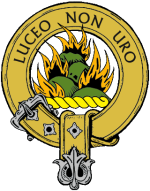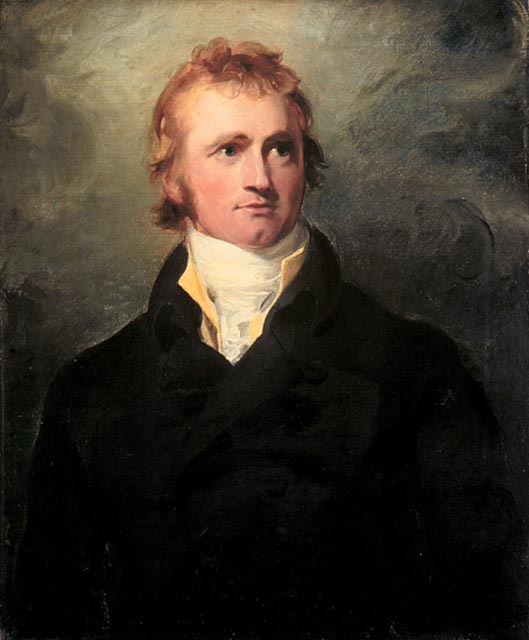 There is a tradition, not borne out, however by any tangible evidence or confirmation, that this very ancient family deduced its descent from a member of the House of Geraldine, in Ireland (whence sprang the noble families of Leinster, Desmond, &c.), who, with a considerable number of his followers, is stated to have settled in Scotland about the year 1261, and to have so powerfully aided King Alexander III, a few years afterwards, in repelling the invasion of Haco, King of Norway, that he was rewarded by a grant of the lands of Kintail, in the County of Ross, which were erected into a free Barony by charter, dated 9th January 1266. Therefore Colin Fitzgerald was the first feudal Baron of Kintail.
There is a tradition, not borne out, however by any tangible evidence or confirmation, that this very ancient family deduced its descent from a member of the House of Geraldine, in Ireland (whence sprang the noble families of Leinster, Desmond, &c.), who, with a considerable number of his followers, is stated to have settled in Scotland about the year 1261, and to have so powerfully aided King Alexander III, a few years afterwards, in repelling the invasion of Haco, King of Norway, that he was rewarded by a grant of the lands of Kintail, in the County of Ross, which were erected into a free Barony by charter, dated 9th January 1266. Therefore Colin Fitzgerald was the first feudal Baron of Kintail.
His grandson who in the Gaelic was called Coinneach MacCoinneach (Kenneth son of Kenneth), 3rd Baron of Kintail, became corrupted in English into Mackenzie (pronounced: MacKenny) and hence arose all the families of Mackenzie in Scotland. The name “Mackenzie” therefore coming from the Gaelic: “MacCoinneach” meaning: “Son of the Fair One”.
Examining records that suggest a descent from the Earls of Ross indicate that such a descent existed through Margaret, the wife of Kenneth A’Blair Mackenzie VIII Baron of Kintail, she was the daughter of John IV Lord of the Isles and Earl of Ross.
A further bit of Clan MacKenzie history
The fate of the Clan Mackenzie was famously foretold by the Brahan Seer (Brahan, near Dingwall, was where the castle stood until it was demolished in 1951). Having risen in power and influence to hold lands which stretched right across Scotland, and to become one of the four most important Highland Chiefs in 1726 (the others were the Dukes of Argyll, Atholl and Gordon), Lord Seaforth’s line ended in the 19th century when all four of his sons died before him.
In a charter granted by King David II in 1362 confirming the lands of Kintail to the Mackenzies, the Clan Mackenzie Chief Murdo is described as a descendant of Gilleoin of the Aird. From that same dynasty of the 12th century stemmed Clans Ross and Matheson. Two centuries later Clan Mackenzie had territories which stretched from the Outer Hebrides right across Scotland to the Black Isle.
Alasdair Mackenzie 7th chief, who d. 1488, was the most prominent supporter of the Crown against the all powerful Lord of the Isles and got his reward in forfeited MacDonald lands. Originally in Kintail around Loch Duich with Eilean Donan Castle as their base, they spread throughout Ross-shire, and into Lewis on the Outer Hebrides. They moved their seat to Kinellan near Strathpeffer, before building Brahan Castle.
Alasdair’s son, Kenneth d. 1492 and his stone effigy can still be seen at Beauly Priory where he was buried. Iain, his son, fought at both Flodden and Pinkie, but survived and lived until the mid 16th century. The Mackenzies continued their rise to power by joining the forces of Mary, Queen of Scots, and James VI against their Gaelic neighbours. In 1609, the chief was made Lord Mackenzie of Kintail, while in 1623 his eldest son became the Earl of Seaforth. The 2nd Earl was Charles II’s secretary of state for Scotland. Another branch of the Mackenzies became the Earls of Cromartie.
It was the Mackenzies’ loyalty to the Stewart Kings which brought about their downfall. Kenneth 4th Earl one of the first Knights of the Thistle, the Scottish Order of Chivalry, followed James VII into exile at the end of the 17th century, the time when the Brahan Seer predicted doom for the house. The 5th Earl raised an army of 3000 men in 1715 for the Jacobite Pretender, and had to flee to France, returning in 1719 to be severely wounded at Glenshiel. Several Mackenzies took part in 1745 rebellion.
Although their influence was now waning, Kenneth 6th Earl, was made Viscount Fortrose and Baron Ardelve, and given Irish Peerage in 1766, and had the title of Earl of Seaforth restored in 1771. In gratitude the chief raised 1000 strong 72nd Regiment, the old Seaforth Highlanders, but he died without male heirs in 1784 and his titles became extinct. The Chiefship and estate passed to his cousin Colonel Thomas Mackenzie, the great grandson of the 3rd Earl. Shortly afterwards, he was killed commanding the Bombay army in India, at the battle of Cheriah. His younger brother, Francis, succeeded him, only to have all his sons die before him and to dispose of much of the Mackenzie land before he himself, the last male descendant of the Mackenzies of Kintail, died in 1815.
His daughter, Mary, was given the Mackenzies’ Arms as Lady Hood-Mackenzie, and from her descend the Stewart-Mackenzies of Seaforth. Her son sold up all the estate except for Brahan and a small part of the Clan Heartland. Her grandson was made Lord Seaforth of Brahan in 1921, but he too died without male heirs, and Brahan Castle was demolished in 1951. The Earl of Cromartie, who renounced his family name of “Blunt” to inherit the title through the female line, is now chief of the Clan Mackenzie. He lives at Castle Leod, Strathpeffer, Ross-shire.
The Mackenzie Clan lands of Kintail, a magnificent 14 000 acres of Highland scenery which include the towering mountains known as the Five Sisters of Kintail, are now in good hands. They were acquired by the National Trust for Scotland in 1944, and the mountaineers, campers and walkers now enjoy the land of Mackenzies. The Trust also looks after another Mackenzie inheritance, the subtropical, exotic gardens created out of barren peninsula at Inverewe in a latitude more Northerly than Moscow, begun by Osgood Mackenzie in 1862 it was presented to the Trust in 1952 by his daughter Mrs Mairi Sawyer.
There have been many distinguished members of the Clan Mackenzie.
Sir Alexander Mackenzie (1764-1820), a Canadian explorer, wrote stirring accounts of his travels across North America.
Alexander Mackenzie (1822-92) second Prime Minister of Canada, born in Perthshire.
Sir John Mackenzie (1838-1901), born at Ard-Ross, was an eminent New Zealand statesman.
Henry Mackenzie (1745-1831) and Sir Compton Mackenzie (1883-1972) were famous literary members of the clan.
William Lyon Mackenzie (1795 – 1861), He was the first mayor of Toronto, Upper Canada and was a leader during the 1837 Upper Canada Rebellion.
William Lyon Mackenzie King, (1875-1950), Canadian political leader from the 1920s through the 1940s. He served as the tenth Prime Minister of Canada from December 29, 1921 to June 28, 1926; from September 25, 1926 to August 7, 1930; and from October 23, 1935 to November 15, 1948.
R. Tait McKenzie (1867 – 1938), Canadian physician, educator, sculptor, athlete, soldier and Scouter.


